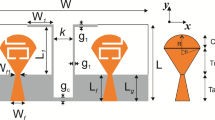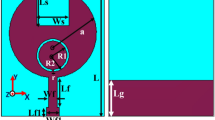Abstract
A two-element multiple-input multiple-output (MIMO) antenna notched at 5.2 GHz frequency is presented for ultra-wideband (UWB) applications. The proposed MIMO antenna possessing spatial diversity performance is a combination of two similar UWB slotted circular patch antennas with split ring resonator (SRR). High isolation between the radiating elements is obtained by inserting a T-shaped stub in between them. Mutual coupling between the elements is minimized because of this reflecting structure in ground plane. The designed antenna is printed on a low dielectric constant substrate RT/Duroid 5880 (dielectric constant єr = 2.2, thickness hs = 0.79 mm, and loss tangent = 0.0009) with an overall size of 52 × 30 mm2. It is observed after the analysis of simulated results that the proposed design of the antenna is acceptable for UWB MIMO wireless communication systems.
Access provided by Autonomous University of Puebla. Download conference paper PDF
Similar content being viewed by others
Keywords
1 Introduction
The research work in the field of UWB wireless applications has increased tremendously in the past few years after the release of UWB spectrum with frequency range from 3.1 to 10.6 GHz by Federal Communications Commission (FCC) [1]. In the field of antennas, ultra-wideband (UWB) technology has gained much emphasis due to its merits like low complexity, low power consumptions, high data rate, and capable to mitigate multipath effect [2]. UWB antennas generally suffer from interference with narrowband frequency signals due to its low power spectrum density. Thus, there is an urgent requirement of UWB antennas possessing band rejection property to suppress the interfering frequency band. UWB system also suffers from multipath fading problem which leads to signal degradation. Multiple-input and multiple-output (MIMO) is a technology which uses multiple transmitting and receiving antennas that act as different channels to transmit and receive data. MIMO technique is capable to increase data rate, capacity, and reliability of antenna system without additional bandwidth or power. It also has a better ability to use multipath in order to increase communication range which makes it suitable for currently growing modern wireless applications. The performance of the antenna is highly influenced by electromagnetic coupling between the radiating antennas in the MIMO arrangement as a result of signal correlation improvement between multiple radio signals [3]. UWB MIMO communication system combining UWB technology with MIMO technology can achieve the requirement of high data transmission rate of 1 Gb/s. At present, ongoing research work on UWB MIMO antennas mainly focus on broadband, high isolation, and band-notched characteristics. Broadband techniques in antennas primarily include resonant structure and slot structures. Isolation enhancement between antenna elements in MIMO system includes adding conductor branches, slotting, current neutralization [4], diversity decoupling, etc., The impedance bandwidth and isolation can be improved with the help of T-shaped slot and a line slot embedded in the ground plane [5]. The requirement of notched band to eliminate signal interference of UWB spectrum with existing narrowband systems of the antennas is fulfilled by embedding slots, branches, loading structures, parasitic elements, split ring resonators (SRR), electromagnetic band gap (EBG) structures, etc. Band rejection characteristics can be achieved in UWB antennas by etching different shaped slots in the patch. A miniaturized and wideband 2 × 1 MIMO antenna with Sierpinski gasket fractal monopoles was proposed [6]. A T-shaped stub was added to ground in order to enhance isolation and impedance bandwidth. A dual band-notched UWB MIMO antenna with orthogonal arrangement of radiating elements for pattern diversity characteristic was introduced for USB dongle applications [7]. Common and extended ground plane was used for notched band at frequencies 3.8 and 5 GHz. Some UWB MIMO antennas are reported with single notched band [8, 9].
This paper presents a single band-notched MIMO antenna for UWB applications with spatial diversity characteristics. A T-stub ground plane is used for isolation enhancement. Simulated reflection coefficient |S11| ≤ −10 dB for each of the two radiating elements and insertion loss |S12| ≤ −17 dB in the entire UWB range. Both the antennas possess band rejection property at 5.2 GHz frequency. The investigated simulated results prove the applicability of the proposed antenna structure for wireless UWB applications. The simulation work has been done using electromagnetic simulation tool CST Microwave Studio.
2 Antenna Design and Analysis
The geometry of single UWB antenna is shown in Fig. 1. An RT/Duroid 5880 substrate of thickness 0.79mm with dielectric constant of 2.2 and loss tangent tan δ = 0.0009 is selected for designing the suggested MIMO antenna. Length and width of the feedline is taken as Lf + Lf1 = 8.85 mm and Wf1 = 3 mm for 50-Ω impedance. In order to achieve notched band at 5.2 GHz frequency, an SRR with 3.8 mm and 3.3 mm as outer and inner radii, respectively, is introduced in the slotted patch. This SRR behave as a band stop filter to avoid interference of WLAN band in UWB spectrum. The overall size of the single antenna element is 30 × 24 mm2. The parameters obtained after rigorous optimization of the design for the required performance of the proposed MIMO antenna are listed in Table 1.
2.1 Design of Two-Element MIMO Configuration
The designed MIMO antenna is a combination of two identical UWB slotted circular patch antennas. Lateral arrangement of monopole antenna elements in the proposed UWB MIMO antenna along with their corresponding dimensions is illustrated in Fig. 2. Overall size of this designed UWB MIMO antenna is 52 × 30 mm2. Isolation enhancement is done by increasing space between antenna elements. The isolation is further enhanced by adding T-shaped stub in the ground as is clearly observed in Fig. 3. Surface current path is increased by the stub which resulted in reduced coupling between antenna elements.
3 Results and Discussion
3.1 Return Loss (S-parameters)
The simulated scattering characteristics and effect of stub on isolation between antenna elements in the suggested MIMO antenna configuration are presented in Fig. 3. Due to symmetry of antenna elements, |S11| is identical to |S22| and |S12| is identical to |S21|. The return loss |S11| ≤ −10 dB with a suppressed band from 4.4 to 5.4 GHz at center frequency 5.2 GHz, and insertion loss ≤−20 dB in most of the band, and it is around −17 dB in frequency range from 7.0–7.9 GHz. Isolation between antenna elements is increased due to addition of T-stub in the ground which controls direct coupling of surface current between antenna elements. S-parameters of single antenna element and the proposed antenna are approximately identical and are shown in Fig. 4. Peak gain of 7.8 dB is obtained for the designed MIMO antenna and is depicted in Fig. 5.
3.2 Diversity Performance Parameters of MIMO Antenna
The diversity performance of the proposed MIMO antenna has been analyzed in terms of envelope correlation coefficient (ECC) and diversity gain (DG) as shown in Fig. 6. The ECC is an important parameter which is a measure of effective MIMO performance if its value is below some threshold value. It measures the field coupling between closely spaced antenna elements in MIMO configuration, and it also give information about how different antennas are correlated with each other.
The ECC and DG of the proposed antenna are determined by the radiation properties of the proposed antenna. In the proposed MIMO configuration, ECC is observed to be less than 0.016 and diversity gain was found to be uniform over the whole UWB band except a dip at notched WLAN band which are within the acceptable limits for good MIMO performance. The present work and the previously reported literatures on MIMO antenna with band-notched behavior are compared in Table 2.
3.3 Far-Field Radiation Characteristics
The co-polar and cross-polar radiation patterns in YOZ and XOZ planes are observed at two frequencies 3.4 and 6.7 GHz. Both the antenna ports in UWB MIMO configuration have radiation patterns which are mirror image of each other due to symmetry of antennas. So, the radiation pattern of only port 1 is shown in Fig. 7.
4 Conclusion
A UWB monopole antenna element and its two-element UWB MIMO antenna configuration with lateral arrangement of antenna elements are proposed in this paper. Reduction in mutual coupling is achieved by exploiting T-stub in the ground plane. The proposed antenna also possesses good impedance bandwidth, uncorrelated radiation patterns, and low envelope correlation coefficient over the entire UWB range. It also possesses good band rejection capability in the frequency band 4.5–5.4 GHz with center frequency at 5.2 GHz. Several diversity performance parameters such as isolation, ECC, and DG which are evaluated are found to be within acceptable limits.
References
Federal Communications Commission (2002) Federal communications commission revision of Part 15 of the Commission’s rules regarding ultra-wideband transmission system from 3.1 to 10.6 GHz, ET-Docket, Washington, DC, USA
Kaiser T, Zheng F, Dimitrov E (2009) An overview of ultra-wide-band systems with MIMO. Proc IEEE 97(2):285–312. https://doi.org/10.1109/JPROC.2008.2008784
Lu J, Ireland D, Schlub R (2005) Dielectric embedded ESPAR (DE-ESPAR) antenna array for wireless communications. IEEE Trans Antennas Propag 53(8):2437–2443. https://doi.org/10.1109/TAP.2005.852517
Tang T-C, Lin K-H (2014) An ultrawideband MIMO antenna with dual band-notched function. IEEE Antennas Wireless Propag Lett 13:1076–1079. https://doi.org/10.1109/LAWP.2014.2329496
Luo CM, Hong JS, Zhong LL (2015) Isolation enhancement of a very compact UWB-MIMO slot antenna with two defected ground structures. IEEE Antennas Wirel Propag Lett 14. https://doi.org/10.1109/LAWP.2015.2423318
Gurjar R, Upadhyay DK, Kanaujia BK, Sharma K (2018) A novel compact self-similar fractal UWB MIMO antenna. Int J RF Microw Comput Aided Eng. https://doi.org/10.1002/mmce.21632
Sipal D, Abegaonkar MP, Koul SK (2018) Compact dual band notched UWB MIMO antenna for USB dongle application with pattern diversity characteristics. Prog Electromagn Res C 87:87–96. https://doi.org/10.2528/pierc18080106
Yadav D, Abegaonkar MP, Koul SK, Tiwari V, Bhatnagar D (2018) Two element band-notched UWB MIMO antenna with high and uniform isolation. Prog Electromagn Res M 63:119–129. https://doi.org/10.2528/pierm17091106
Liu L, Cheung SW, Yuk TI (2015) Compact MIMO antenna for portable UWB applications with band-notched characteristic. IEEE Trans Antennas Propag 63(5):1917–1924. https://doi.org/10.1109/TAP.2015.2406892
Mathur R, Dwari S (2018) Compact CPW fed ultrawideband MIMO antenna using hexagonal ring monopole antenna elements. Int J Electron Commun (AEU) 93:1–6. https://doi.org/10.1016/j.aeue.2018.05.032
Kang L, Li H, Wang X, Shi X (2015) Compact offset microstrip-fed MIMO antenna for band notched UWB applications. IEEE Antennas Wirel Propag Lett 14. https://doi.org/10.1109/LAWP.2015.2422571
Liu G, Liu Y, Gong S (2017) Compact uniplanar UWB MIMO antenna with band-notched characteristic. Microwave Opt Technol Lett 59. https://doi.org/10.1002/mop.30700
Zhu J, Li S, Feng B, Deng L, Yin S (2016) Compact dual-polarized UWB quasi-self-complementary MIMO/diversity antenna with band-rejection capability. IEEE Trans Antennas Propag Lett 15 (2016). https://doi.org/10.1109/LAWP.2015.2479622
Chacko BP, Augustin G, Denidni TA (2013) Uniplanar slot antenna for ultrawideband polarization—diversity applications. IEEE Antenna Wireless Propag Lett 12 (2013). https://doi.org/10.1109/LAWP.2013.2242841
Acknowledgements
The authors would like to acknowledge University of Rajasthan, Jaipur, for their encouragement and support.
Author information
Authors and Affiliations
Editor information
Editors and Affiliations
Rights and permissions
Copyright information
© 2022 The Author(s), under exclusive license to Springer Nature Singapore Pte Ltd.
About this paper
Cite this paper
Saleem, S., Kumari, S., Yadav, D., Bhatnagar, D. (2022). SRR Loaded WLAN Band-Notched UWB MIMO Antenna with Spatial Diversity Characteristics. In: Tiwari, M., Maddila, R.K., Garg, A.K., Kumar, A., Yupapin, P. (eds) Optical and Wireless Technologies. Lecture Notes in Electrical Engineering, vol 771. Springer, Singapore. https://doi.org/10.1007/978-981-16-2818-4_33
Download citation
DOI: https://doi.org/10.1007/978-981-16-2818-4_33
Published:
Publisher Name: Springer, Singapore
Print ISBN: 978-981-16-2817-7
Online ISBN: 978-981-16-2818-4
eBook Packages: EngineeringEngineering (R0)











